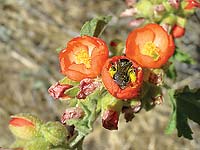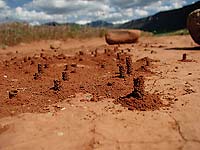The entire Manti-La Sal NF Management Plan is being revised for the first time in 34 years. Pollinators is one of the 60 sections. The MLNF is so far proposing to permit honey bee apiaries.
Imagine you are a public land manager and a beekeeper is in your office requesting a permit to park 100 boxes of honey bees four months a year on the national forest you manage. Each box (hive) houses 10,000-60,000 honey bees. You can help the beekeeper’s business and grant the permit. Your agency’s regulations say you can issue the permit without notifying the public or assessing any consequences of issuing the permit.
 |
| Diadasia bees are specialists on a relatively small number of plants, and in the Moab area mallow is one of those plants. |
You might, though, have heard that some researchers have documented non-native honey bees outcompeting native bees for collecting limited amounts of pollen and nectar needed by the native bees to produce new bees. You’ve heard that other scientists found that honey bees can transmit their diseases to the native bees (and vice-versa). But perhaps you’ve never seen any of the mostly solitary native bees on the lands you manage – even though there may be a hundred different species of such bees on those lands. You’ve likely never seen a native bee’s nest. You’ve almost certainly never seen a bee with stubby wings indicating it has “tested positive” for deformed wing virus.
This is about making decisions informed by “best available science.” You can see when non-native goats excavate wallows in an alpine meadow. You can see a noxious weed around a livestock water tank. You can see dead pinyon trees following a drought. But once you issue the honey bee permit, will you see whether the males of a rare bumblebee species have become smaller in the vicinity of the honey bee hives? After you issue a honey bee permit, will you notice whether seed production has declined in a rare native plant that is dependent on a particular native bee species for pollination?
 |
| Small towers built by Diadasia bees in Castle Valley. A Diadasia bee builds her tower above an underground nest where she lays her eggs on the pollen she has gathered. |
This is the need for decisionmakers to consider what scientists have studied, how they studied it, and what they found. One scientist has tracked down bumblebee queens near and far from honey bee hives, and weighed the queens and males. Another has studied visits by a species of a solitary native bee to two populations of a rare native plant - one where honey bees are present and another where honey bees are absent. Another has looked for the RNA of a disease virus common in honey bees in the gut, trachea and legs of bumblebees species exposed to honey bees and bumblebees not exposed to honey bees.
It’s particularly hard to make decisions when you are weighing something you can see and readily relate to (e.g., a business person requesting a permit) against something you haven’t seen, but some scientists have (e.g., native bees sick with deformed wing virus). But that’s the core importance of any requirement, that a decisionmaker consider best available science. Many lives, seen and unseen, may depend on that.
Mary O’Brien is a Castle Valley resident whose PhD work focused on pollination by wasps. She is soon leaving Grand Canyon Trust after 17 years as Utah Forests Program Director. One post-Trust endeavor is initiating a small organization called Project Eleven Hundred. (There are 1,100 species of native bees in Utah).
|